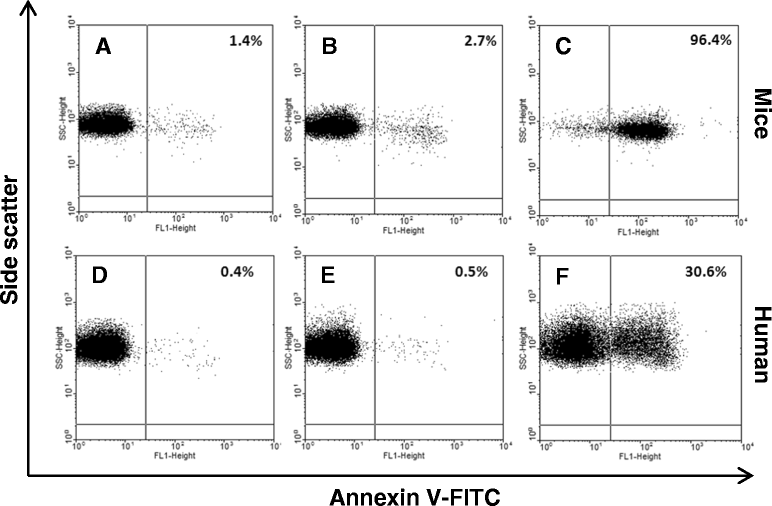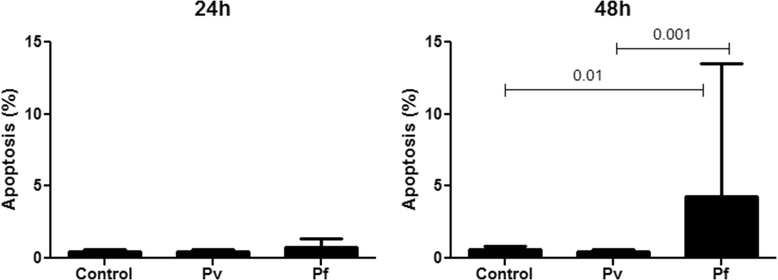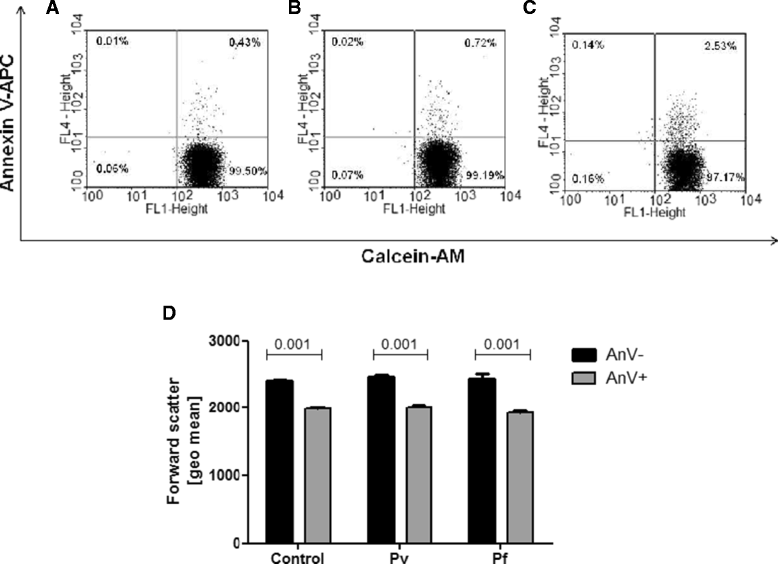Plasmodium falciparum, but not P. vivax, can induce erythrocytic apoptosis
- PMID: 25325923
- PMCID: PMC4206708
- DOI: 10.1186/s13071-014-0484-8
Plasmodium falciparum, but not P. vivax, can induce erythrocytic apoptosis
Abstract
Background: Apoptosis can occur in red blood cells (RBC) and seems to be involved in hematologic disorders related to many diseases. In malaria it is known that parasitized RBC (pRBC) is involved in the development of anemia and thrombosis; however, non-parasitized RBC (nRBC) apoptosis could amplify these malaria-associated hematologic events. In fact, in experimental malaria, increased levels of apoptosis were observed in nRBC during lethal Plasmodium yoelii 17XL infection, but in human malaria erythrocytic apoptosis has never been studied. The present study was performed to investigate if nRBC apoptosis also occurs in P. vivax and P. falciparum infections.
Findings: Apoptosis of nRBC was evaluated in blood samples of P. vivax malaria patients and clinically healthly individuals living in Manaus, Brazil, both ex vivo and after incubation of RBC for 24 h. Additionally, the capacity of plasma from P. vivax or P. falciparum patients was tested for induction of in vitro apoptosis of normal RBC from a clinically healthy individual living in a non-endemic malaria region. Apoptosis was detected by flow cytometry using annexin V staining. In contrast to experimental malaria that significantly increased the levels of apoptotic nRBC both ex-vivo and after 24 h of incubation, no significant alteration on apoptotic nRBC rates was detected in P. vivax infected patients when compared with non-infected control individuals. Similar results were observed when plasma of these P. vivax patients was incubated with normal RBC. Conversely, plasma from P. falciparum-infected subjects induced significant apoptosis of these cells.
Conclusions: Apoptosis of normal RBC can be induced by plasma from individuals with P. falciparum (but not with P. vivax) malaria. This finding could reflect the existence of erythrocytic apoptosis during infection that could contribute to the pathogenesis of hematological and vascular complications associated with falciparum malaria.
Figures



Similar articles
-
Competition for red blood cells can enhance Plasmodium vivax parasitemia in mixed-species malaria infections.Am J Trop Med Hyg. 2006 Jul;75(1):112-25. Am J Trop Med Hyg. 2006. PMID: 16837717 Free PMC article.
-
Haematological response in experimental human Plasmodium falciparum and Plasmodium vivax malaria.Malar J. 2021 Dec 20;20(1):470. doi: 10.1186/s12936-021-04003-7. Malar J. 2021. PMID: 34930260 Free PMC article.
-
[The importance of the contribution of rapid test, serological and molecular methods in the diagnosis of two imported malaria cases with atypical microscopy].Mikrobiyol Bul. 2017 Oct;51(4):396-403. doi: 10.5578/mb.61822. Mikrobiyol Bul. 2017. PMID: 29153070 Turkish.
-
Out of Africa: origins and evolution of the human malaria parasites Plasmodium falciparum and Plasmodium vivax.Int J Parasitol. 2017 Feb;47(2-3):87-97. doi: 10.1016/j.ijpara.2016.05.008. Epub 2016 Jul 2. Int J Parasitol. 2017. PMID: 27381764 Free PMC article. Review.
-
The Rheopathobiology of Plasmodium vivax and Other Important Primate Malaria Parasites.Trends Parasitol. 2017 Apr;33(4):321-334. doi: 10.1016/j.pt.2016.11.009. Epub 2016 Dec 29. Trends Parasitol. 2017. PMID: 28040374 Review.
Cited by
-
Evidencing the Role of Erythrocytic Apoptosis in Malarial Anemia.Front Cell Infect Microbiol. 2016 Dec 9;6:176. doi: 10.3389/fcimb.2016.00176. eCollection 2016. Front Cell Infect Microbiol. 2016. PMID: 28018860 Free PMC article. Review.
-
Extracellular vesicles carrying lactate dehydrogenase induce suicide in increased population density of Plasmodium falciparum in vitro.Sci Rep. 2019 Mar 25;9(1):5042. doi: 10.1038/s41598-019-41697-x. Sci Rep. 2019. PMID: 30911042 Free PMC article.
-
Extracellular Vesicles Could Carry an Evolutionary Footprint in Interkingdom Communication.Front Cell Infect Microbiol. 2020 Mar 3;10:76. doi: 10.3389/fcimb.2020.00076. eCollection 2020. Front Cell Infect Microbiol. 2020. PMID: 32195195 Free PMC article. Review.
-
Of membranes and malaria: phospholipid asymmetry in Plasmodium falciparum-infected red blood cells.Cell Mol Life Sci. 2021 May;78(10):4545-4561. doi: 10.1007/s00018-021-03799-6. Epub 2021 Mar 13. Cell Mol Life Sci. 2021. PMID: 33713154 Free PMC article. Review.
-
Single-Cell RNA Sequencing Reveals Cellular Heterogeneity and Stage Transition under Temperature Stress in Synchronized Plasmodium falciparum Cells.Microbiol Spectr. 2021 Sep 3;9(1):e0000821. doi: 10.1128/Spectrum.00008-21. Epub 2021 Jul 7. Microbiol Spectr. 2021. PMID: 34232098 Free PMC article.
References
-
- Bratosin D, Estaquier J, Petit F, Arnoult D, Quatannens B, Tissier JP, Slomianny C, Sartiaux C, Alonso C, Huart JJ, Montreuil J, Ameisen JC. Programmed cell death in mature erythrocytes: a model for investigating death effector pathways operating in the absence of mitochondria. Cell Death Differ. 2001;8:1143–1156. doi: 10.1038/sj.cdd.4400946. - DOI - PubMed
Publication types
MeSH terms
LinkOut - more resources
Full Text Sources
Other Literature Sources

